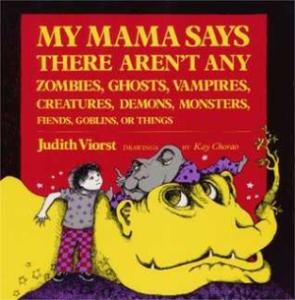Maybe there aren't any ghosts, but there definitely are things.

I remember enjoying this book as a child. Which is kind of strange, because as an adult, it almost seems like it might be too scary for a child. Maybe too scary for a young child.
The story: a little boy, about six or seven, is talking about various things that he's afraid of. His mama says that the monsters he's afraid of aren't really there. There's no monster scratching at his window; there's no vampire flying over his house; there's no ghost in his closet. But it alternates between talking about how his mama says they don't exist, and relating events where his mama was wrong. "But yesterday my mama said I couldn't have some cream cheese on my sandwich, because, she said, there wasn't any more. And then I found the cream cheese under the lettuce in back of the Jello. So... sometimes even mamas make mistakes." Things that humanize the mother.
I think that was something I really appreciated as a child, that my parents, my mother especially, weren't afraid to admit when they were wrong, or had made a mistake, and read books like this that depict the parent as not always being in the right. "But Monday Mama said she put my crayons on my shelf. Just use your eyes, she said, and you will find them. I can't. You can. I can't. You can. I can't. All right! I'll find them, she said (not very nicely). But, guess what? She couldn't, too. So... sometimes even mamas make mistakes." And the very last one in the book is that a creature is coming after him, and he's afraid because the creature grabs him. And it turns out that it's not a creature but his mama in a blanket. And the last two sentences are, "Well, sometimes even mamas make mistakes. But sometimes they don't."
The illustrations are really well done black and white ink drawings. A lot of the subtle detail on the monsters implies that they are actually everyday objects that the boy is misinterpreting. For example, the ghost in his closet's tie is partly made of a sock, suggesting that the ghost is made of a pile of clothes.
I would be wary of reading this to an overly sensitive child, although I would identify my child self as a easily scared and I wasn't messed up. The monsters, while not realistic, might put ideas in the child's head, like a fiend that sneaked into his lower bunk. "And he's sniffing around for a boy to eat, and I'm the boy that he's sniffing, and... My mama says no fiends have sneaked in here." I guess it captures the insecurity of childhood with a vivid imagination, where you can't be sure that things aren't out to get you. And you know your parents are reassuring you, but can you trust them when you know they make mistakes? The book doesn't really resolve this question. In the last case, it's his mom in a blanket, but what about the others? There's no answers at the end. It's a lot like one of the author's other books, "Alexander and the Terrible, Horrible, No Good, Very Bad Day," where one of the last sentences is, "Some days are like that." And you have to deal with it. It's a very realistic message, with nothing sugarcoated. It's true and it resonated with me as a child. I worried about a lot of things and identified with this child.
I guess the lack of realism in the drawings of the monsters is what made this not as scary to me as a child, and that monsters were not really what I worried about. The realism of the story and the humanizing of the mother are really good.
But know your child. Know whether this will add to their worries or ease them.